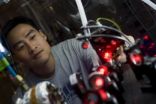END
Report casts world's rivers in 'crisis state'
2010-09-30
(Press-News.org) EDITOR'S NOTE: Images to accompany this story are available at http://www.news.wisc.edu/newsphotos/river-crisis.html
ELSE PRESS RELEASES FROM THIS DATE:
Global study finds widespread threats to world's rivers
2010-09-30
Multiple environmental stressors, such as agricultural runoff, pollution and invasive species, threaten rivers that serve 80 percent of the world's population, around 5 billion people, according to researchers from The City College (CCNY) of The City University of New York (CUNY), University of Wisconsin and seven other institutions. These same stressors endanger the biodiversity of 65 percent of the world's river habitats and put thousands of aquatic wildlife species at risk.
The findings, reported in the September 30 issue of Nature, come from the first global-scale ...
One-dimensional window on superconductivity, magnetism
2010-09-30
HOUSTON -- (Sept. 29, 2010) -- A Rice University-led team of physicists is reporting the first success in a three-year effort to build a precision simulator for superconductors using a grid of intersecting laser beams and ultracold atomic gas.
The research appears this week in the journal Nature. Using lithium atoms cooled to within a few billionths of a degree of absolute zero and loaded into optical tubes, the researchers created a precise analog of a one-dimensional superconducting wire.
Because the atoms in the experiment are so cold, they behave according to the ...
Scientists stack up new genes for height
2010-09-30
CHAPEL HILL – An international team of researchers, including a number from the University of North Carolina at Chapel Hill schools of medicine and public health, have discovered hundreds of genes that influence human height.
Their findings confirm that the combination of a large number of genes in any given individual, rather than a simple "tall" gene or "short" gene, helps to determine a person's stature. It also points the way to future studies exploring how these genes combine into biological pathways to impact human growth.
"While we haven't explained all of the ...
For the first time, monkeys recognize themselves in the mirror, indicating self-awareness
2010-09-30
EDITOR'S NOTE: An image and video are available at http://www.news.wisc.edu/newsphotos/macaque-mirror.html
The study, with several videos of the monkeys, appears in today's PLoS One, at http://dx.plos.org/10.1371/journal.pone.0012865 END ...
Research on killer HIV antibodies provides promising new ideas for vaccine design
2010-09-30
New discoveries about the immune defenses of rare HIV patients who produce antibodies that prevent infection suggest a novel direction for designing new vaccines. Researchers at Rockefeller University and colleagues have now made two fundamental discoveries about the so called broadly neutralizing anti-HIV antibodies, which effectively keep the virus at bay. By detailing the molecular workings of a proven immune response, the researchers hope their work will ultimately enable them to similarly arm those who are not equipped with this exceptional immunological firepower. ...
Increased risk of other cancers for relatives of women with early onset breast cancer
2010-09-30
Close relatives of women diagnosed with breast cancer before the age of 35 years are at an increased risk of developing other cancers, according to a University of Melbourne study, published in the British Journal of Cancer today.
Professor John Hopper, Director of Research from the Centre for Molecular, Environmental, Genetic and Analytic Epidemiology at the University of Melbourne, Australia, a lead investigator in the study, said these are surprising and novel findings which could be pointing to the existence of a new cancer genetic syndrome.
"The results suggest ...
Diet when young affects future food responses
2010-09-30
A high protein diet during development primes the body to react unhealthily to future food binges. A study on juvenile rats, published in BioMed Central's open access journal Nutrition and Metabolism, suggests that lasting changes result from altering the composition of the first solid food that is consumed throughout growth into early adulthood.
Raylene Reimer worked with a team of researchers from the University of Calgary, Canada, to carry out the weaning experiments in 18 litters of rats. Six litters were placed on each of three diets: high prebiotic fiber, high ...
Newly discovered planet may be first truly habitable exoplanet
2010-09-30
SANTA CRUZ, CA--A team of planet hunters led by astronomers at the University of California, Santa Cruz, and the Carnegie Institution of Washington has announced the discovery of an Earth-sized planet (three times the mass of Earth) orbiting a nearby star at a distance that places it squarely in the middle of the star's "habitable zone," where liquid water could exist on the planet's surface. If confirmed, this would be the most Earth-like exoplanet yet discovered and the first strong case for a potentially habitable one.
To astronomers, a "potentially habitable" planet ...
A 'giant' step toward explaining differences in height
2010-09-30
Boston, Mass. -- An international collaboration of more than 200 institutions, led by researchers at Children's Hospital Boston, the Broad Institute, and a half-dozen other institutions in Europe and North America, has identified hundreds of genetic variants that together account for about 10 percent of the inherited variation of height among people.
Known as the GIANT (Genetic Investigation of ANthropometric Traits) Consortium, the collaboration pooled data from more than 180,000 individuals, including millions of genetic results from each of 46 separate studies in the ...
Potentially habitable planet discovered
2010-09-30
Washington, D.C. Astronomers have found a new, potentially habitable Earth-sized planet. It is one of two new planets discovered around the star Gliese 581, some 20 light years away. The planet, Gliese 581g, is located in a "habitable zone"—a distance from the star where the planet receives just the right amount of stellar energy to maintain liquid water at or near the planet's surface. The 11- year study, published in the Astrophysical Journal and posted online at arXiv.org, suggests that the fraction of stars in the Milky Way harboring potentially habitable planets could ...
